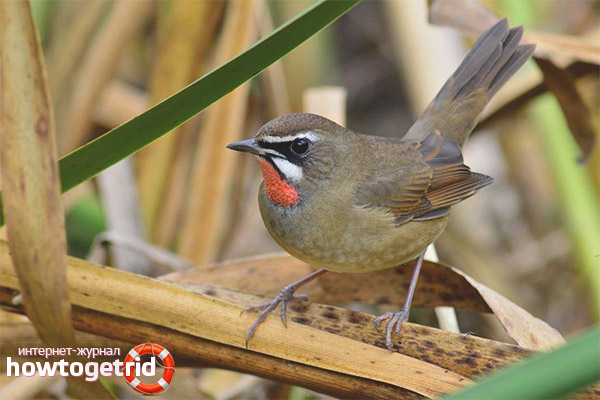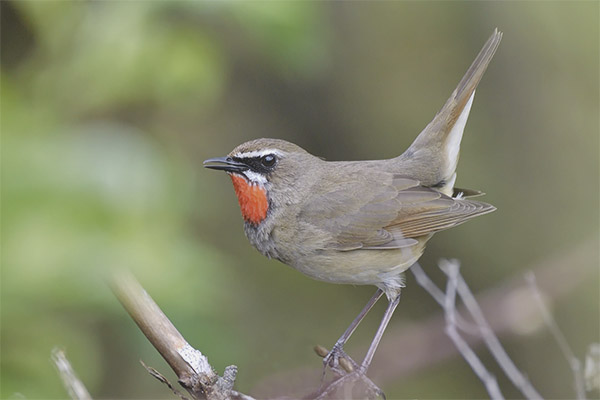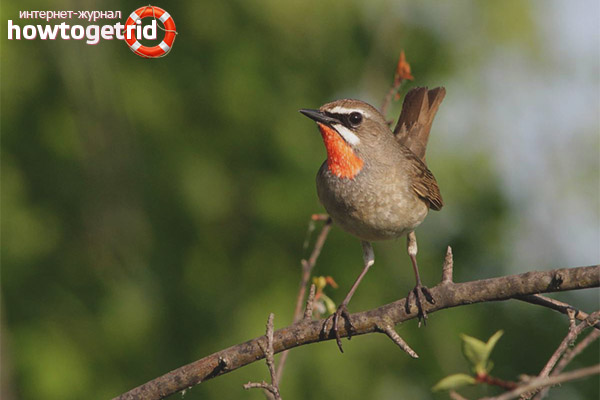The content of the article
The nightingale is a seemingly unpretentious bird that stands out among the rest neither by appearance nor color. But the bird, thanks to its clear, clear and stunningly beautiful voice, is known to all. Most people believe that nightingales are found mainly in the area of Kursk and Tula. But this is not quite the case, and it will be a question of the nightingale-red-wolf that lives in North-Asian regions of Russia.
Appearance
Nightingale-Krasnosheika - a representative of the passerine detachment, the family of thrushes. It is rather difficult to describe it - the appearance is so poor.
The size is small - length is 16-18 cm, weighs 20-28 g, looks and looks like an ordinary nightingale. The same brown-olive top, whitish abdomen, wings and tail are covered with a slight red bloom, as if a black mask is worn over the head, trimmed with white stripes on the top and bottom sides.The only feature is that the neck and throat of the male are covered with a kind of “tie” of bright red color with dark stripes.
The females look different from the males - the throat is whiter, the red tie appears in light strokes, the white “eyebrows” and “whiskers” are less contrasted, and the color of feathers is dimmer than among males.
Habitat
It inhabits the Ural Mountains from the Asian side in Eastern Siberia, Central and Eastern Western. Lives up to Kamchatka and Sakhalin, lodges in the north of Mongolia and in the South Chinese mountains. It inhabits undergrowth and shrubby taiga zone, loves marshy areas with high humidity, overgrown with small trees. The red-headed nightingale is difficult to see with the naked eye - it is hidden in the thickets of grass and shrubs, keeping close to the ground.
Nesting and breeding
Eggs the female lays in clear weather May days, in clutch from two to six pieces, most often - 4-5 eggs bluish, grayish-green or light-colored, decorated from the blunt end with red pigmentation or brownish specks.
Only the female incubates the testicles for two weeks. In early June, chicks covered with sparse fluff are born. Within 11-13 days both parents are engaged in feeding them. At the beginning of the second summer month, the chicks, not yet able to fly, leave the nest and live on the ground. Their parents are taught to disguise, hide from danger in the grass thickets and continue to supply food.With the onset of August, the youngsters get up on the wing and leave their parents, going into an independent life.
Wintering

Being migratory birds, red-necked nightingales fly to warm regions at the end of summer - beginning of autumn. They winter in Africa, Iran and on the Mediterranean coast.
Nutrition
In food, the red-headed nightingale is undemanding, it feeds mostly on animal food — various kinds of insects such as weevils, bedbugs, leaf beetles and snails, spiders, digs out worms from the ground. He does not like to hunt in the air, and he does this very rarely. With the onset of cold weather, when there are few insects, eagerly eats berries and fruits.
Singing
For many centuries, it is believed that nightingales are unsurpassed singers. And indeed - their charming voice penetrates the soul, forcing you to worry and enjoy the enchanting trills. Singing consists of the so-called "knees", bearing, depending on the order, different names - "whistle", peals "," fractions ". The bird sings at any time - even during the day, at least in the evening, at least in the morning. In the 19th century, landowners and noblemen specially purchased nightingales and kept in a cage to delight the ears with singing.
Nightingales are good imitators and imitators. It is worthwhile for a beautiful singer to appear in the area, as all the living birds begin to sing even better than before.
Interesting Facts
- Red-haired singing is very beautiful, perhaps, would not give way to the songs of the recognized masters of this business - Kursk nightingales. But less long - the red-faced nightingale quickly exhales.
- If a bird is frightened, it switches from beautiful singing to whistling and rattling.
- Only males delight the human ear with singing, caring for the lady of the heart and giving her various attentions, but when the chicks come out of the eggs, the father stops singing and is only engaged in providing heirs with food.
- Scientists have established: nightingale singing is not an innate skill. It is acquired when the chick listens to the parent trills and learns to sing from them. We conducted the experiment - fed the chick artificially, without the participation of parents. He, of course, later sang, but he sang much worse than the chicks that grew with their parents.
- During singing, the males strictly wait for their turn to perform and do not try to break into someone else's performance.
- Ornithologists have found a pattern - in the afternoon and evening, the nightingales sing, guarding their plot and marking the territory. And only at night singing is intended to attract female birds.
- A bird spends a huge amount of energy on singing, and for its full recovery a nightingale can eat almost as much food as he weighs.
- The speed of flight of this little bird can reach 50 kilometers per hour.
The nightingale lives in the nature of 10-11 years, and all this time it returns to the same place where it once made a nest. The fact that the nightingales are very picky about the choice of residence. They do not want to start looking for a new place and start building anew.
Video: Red Nightingale Nightingale (Luscinia calliope)












To send